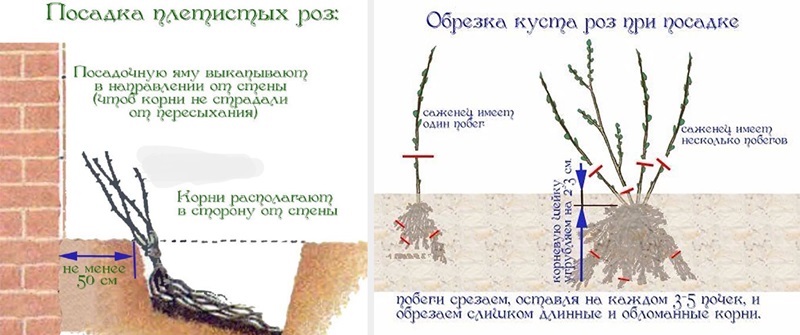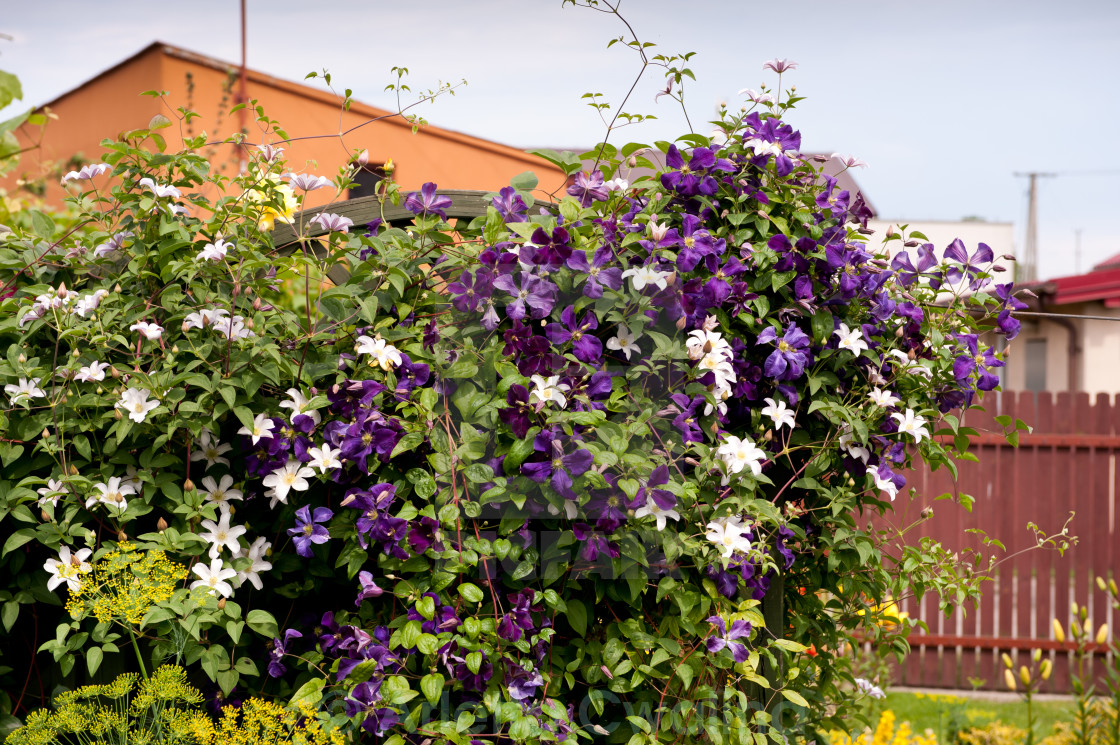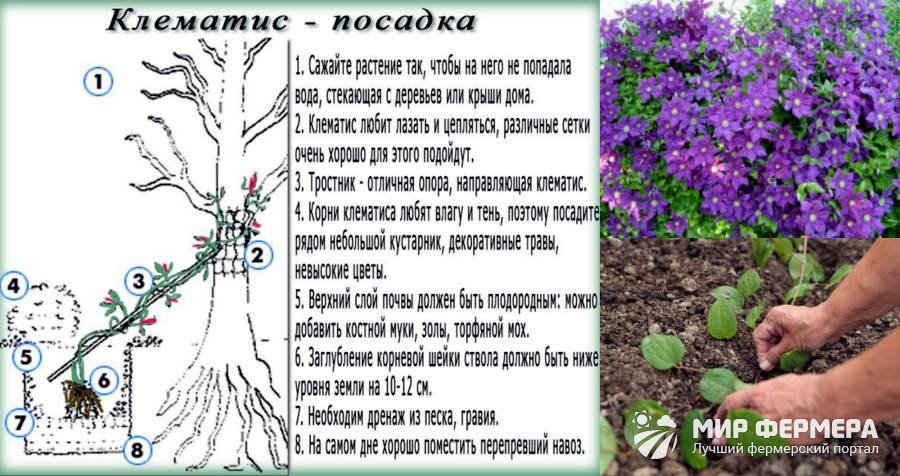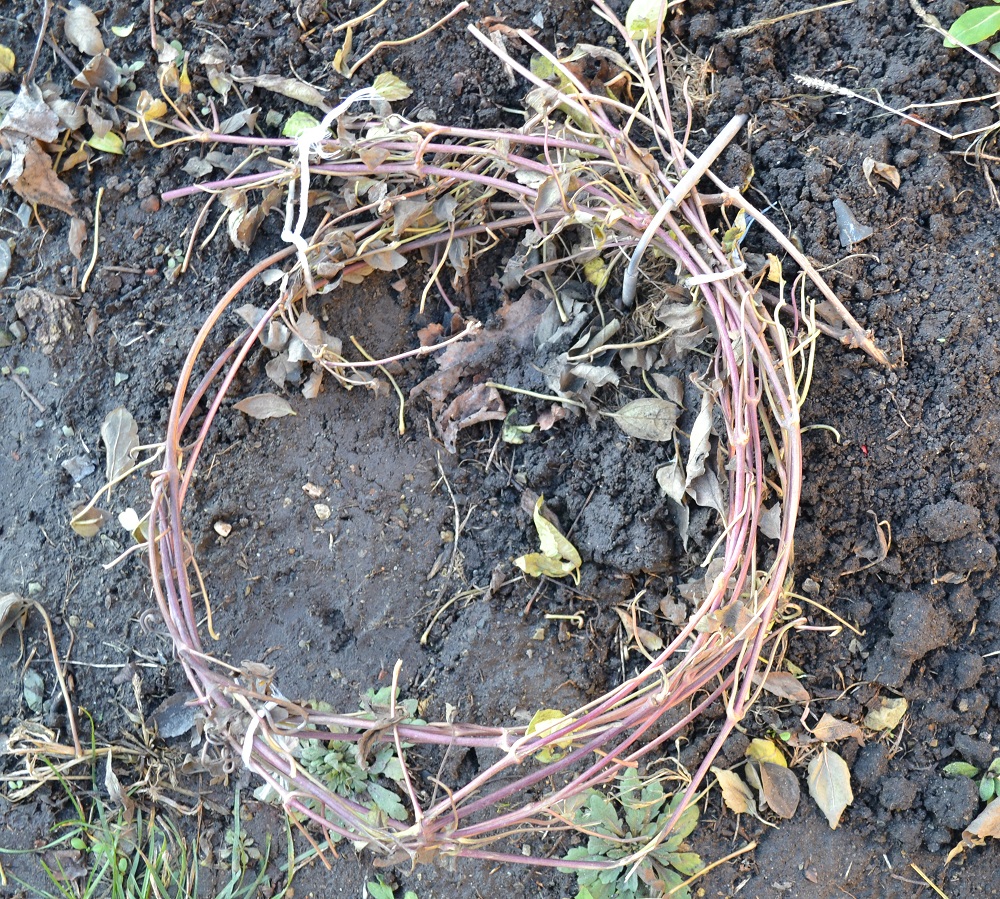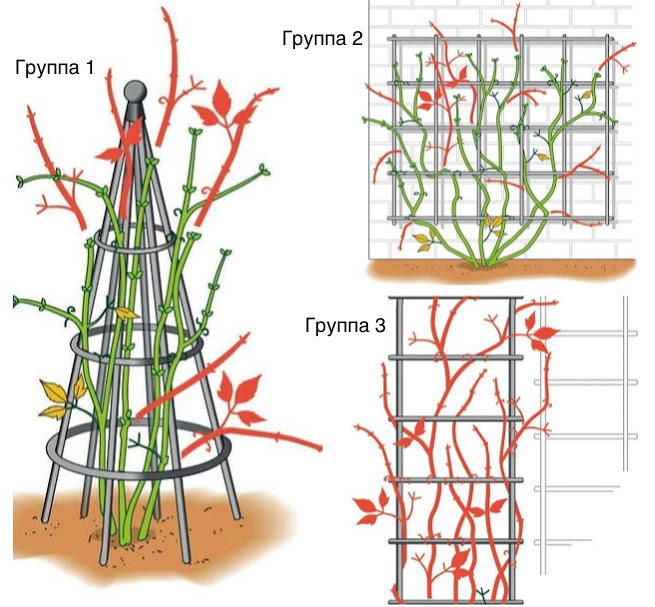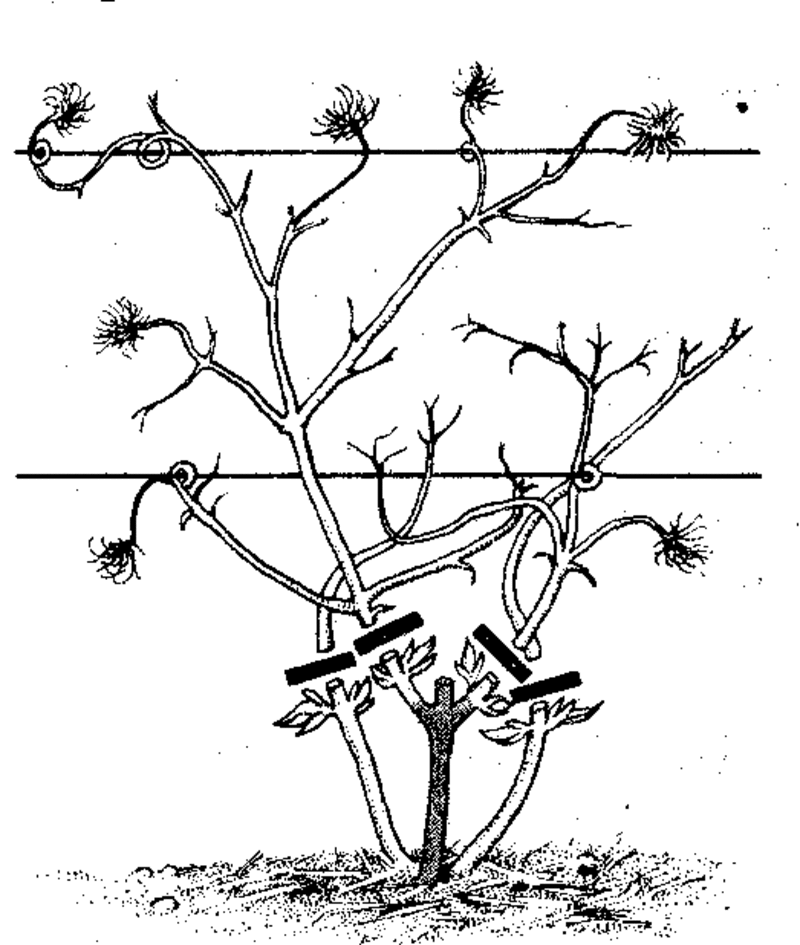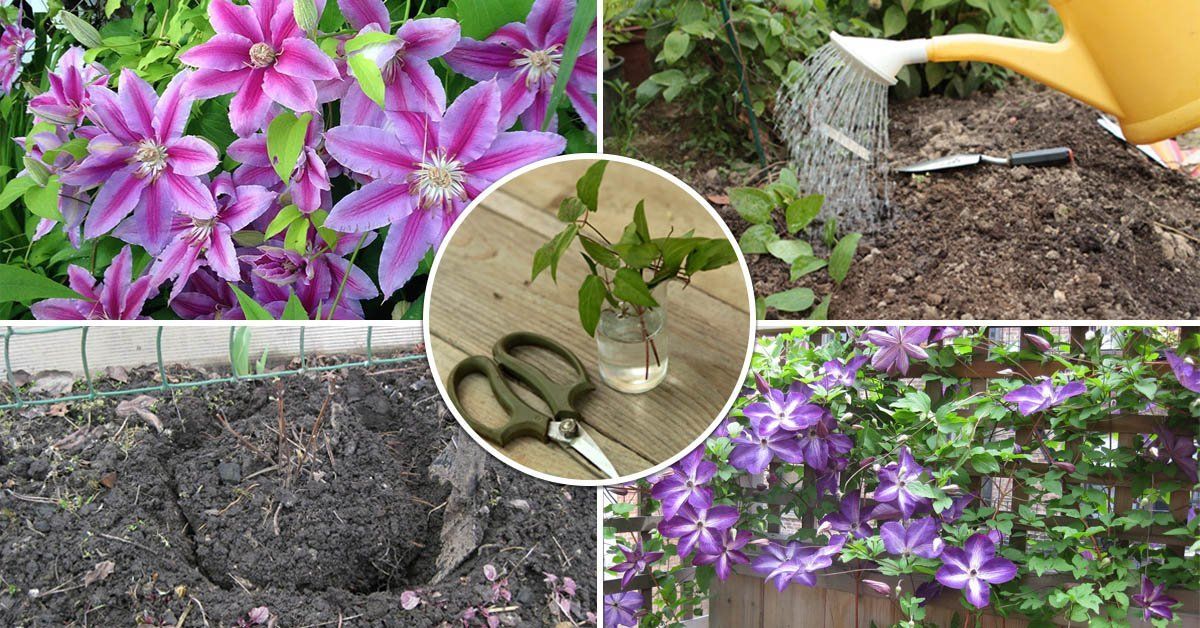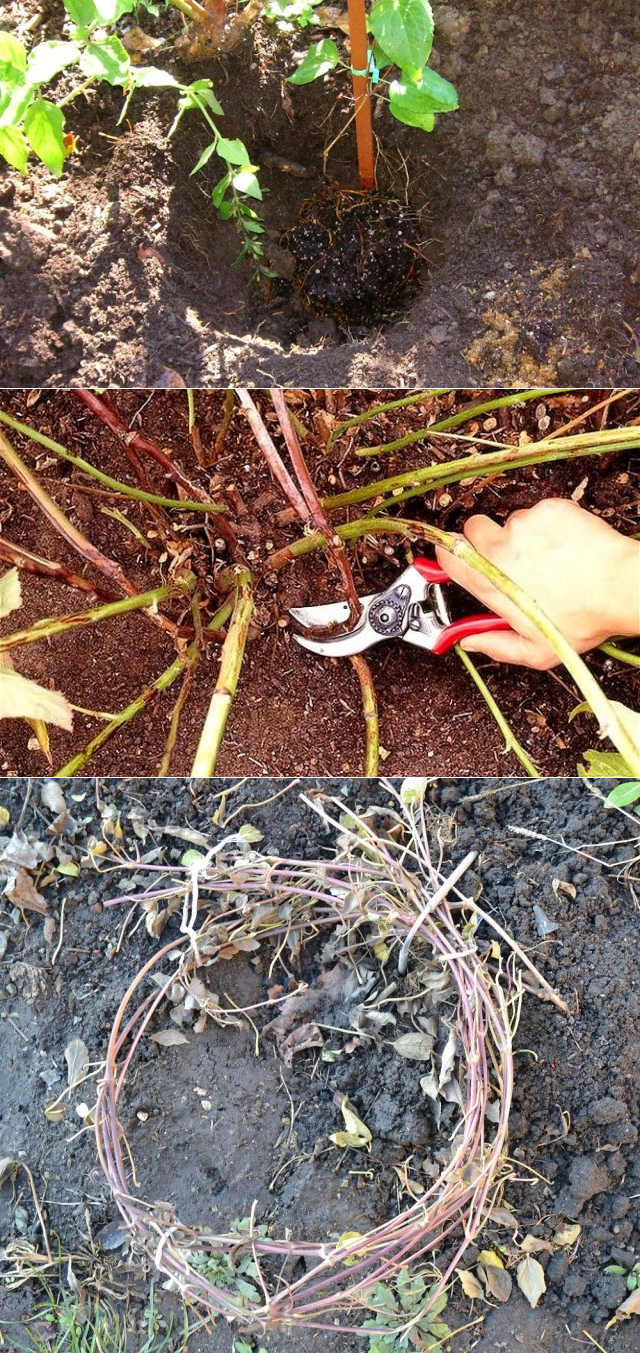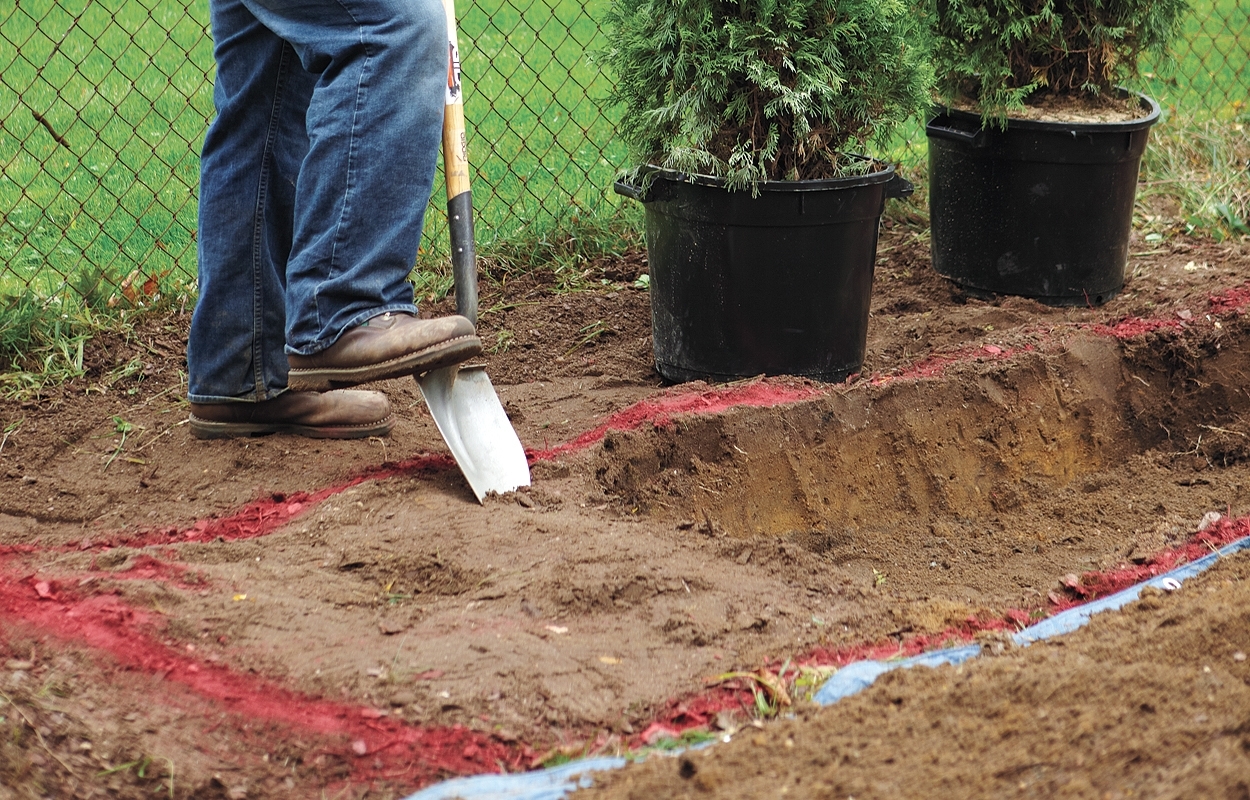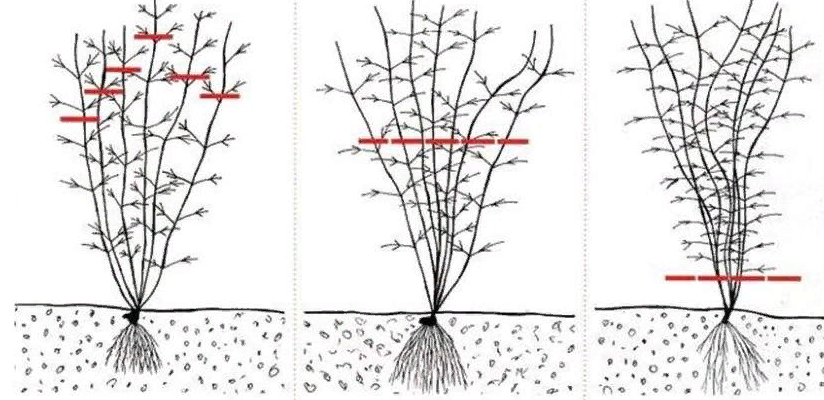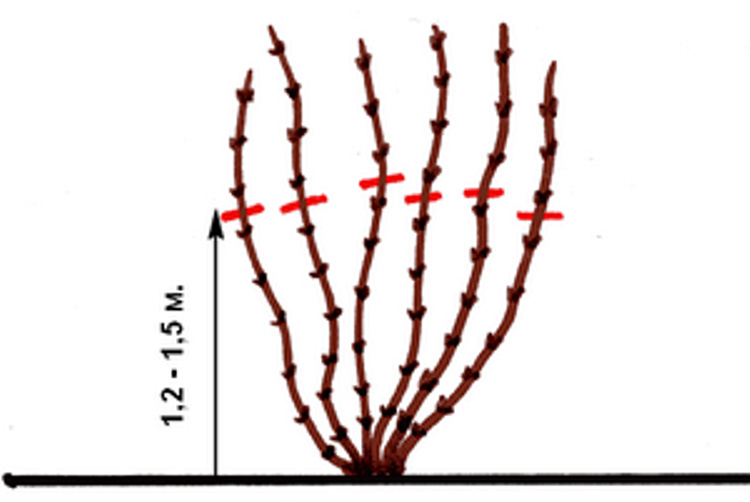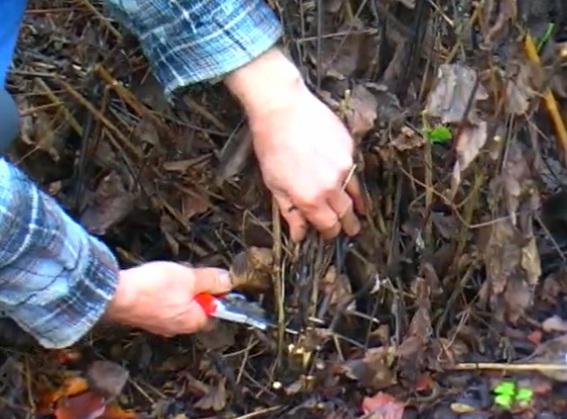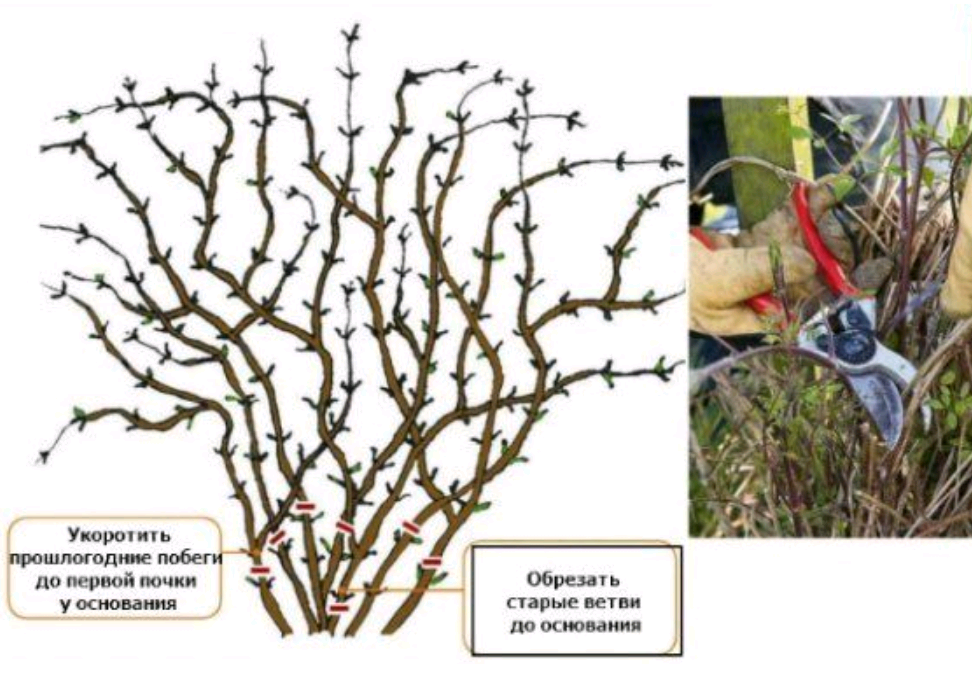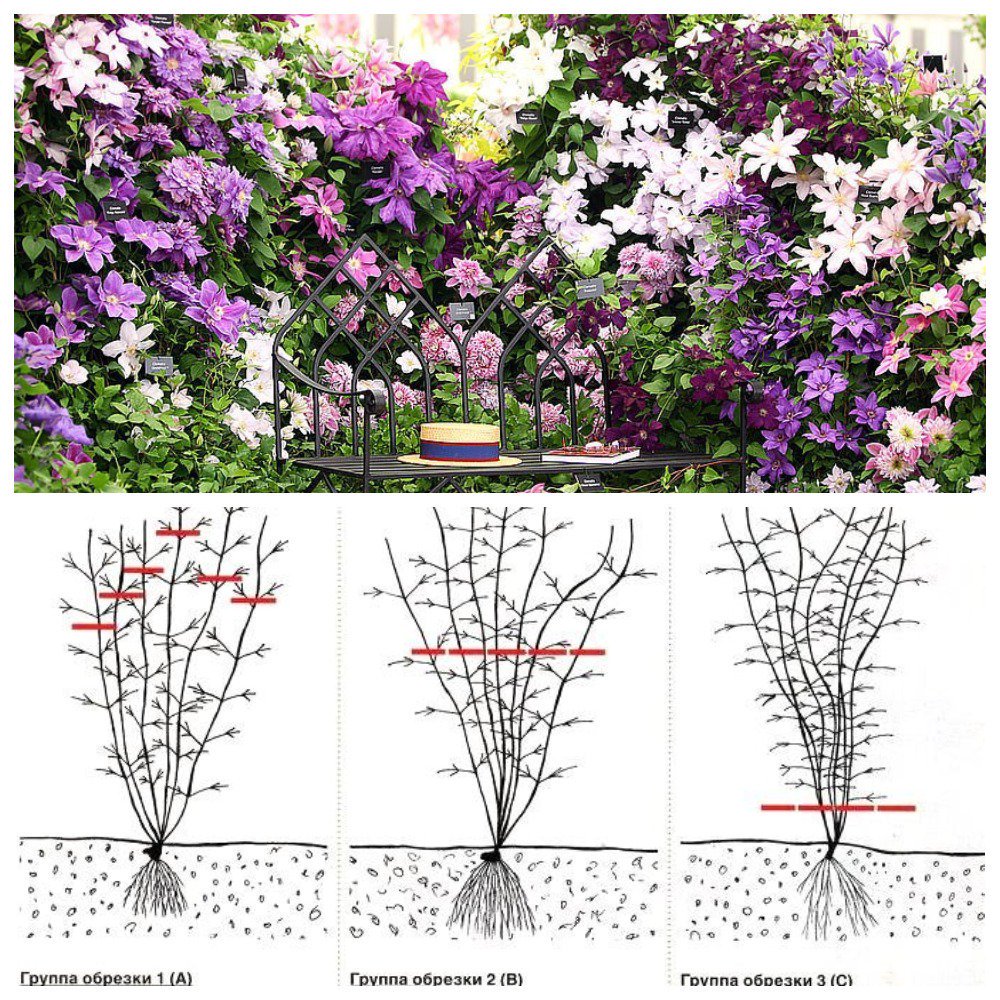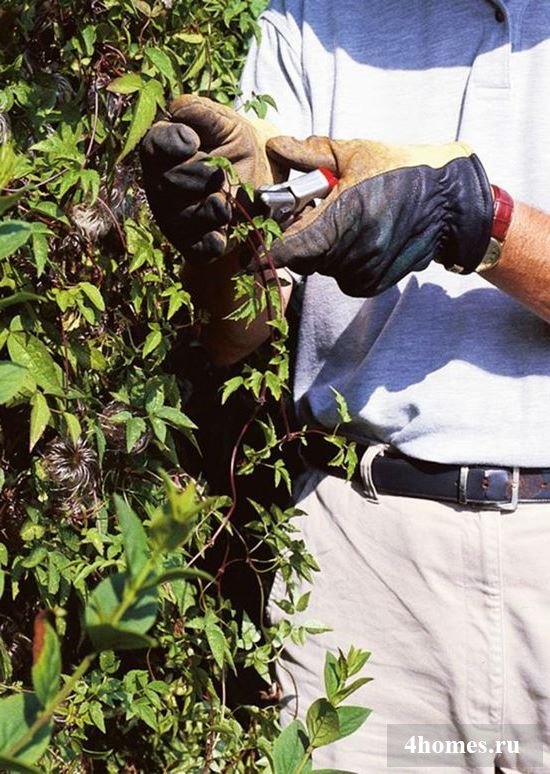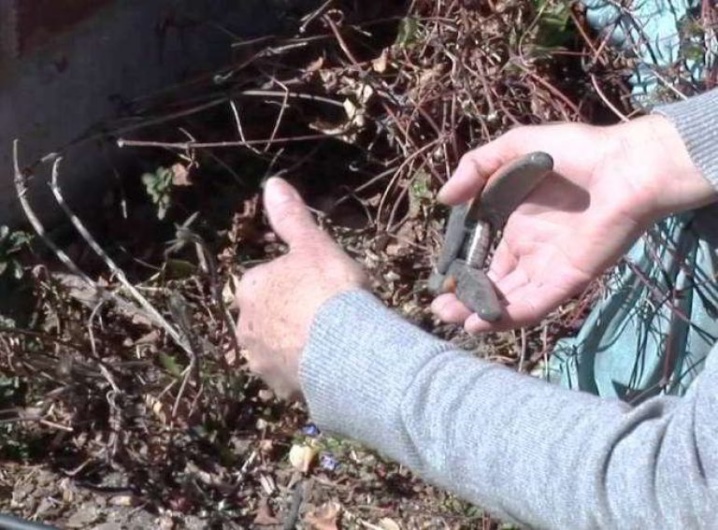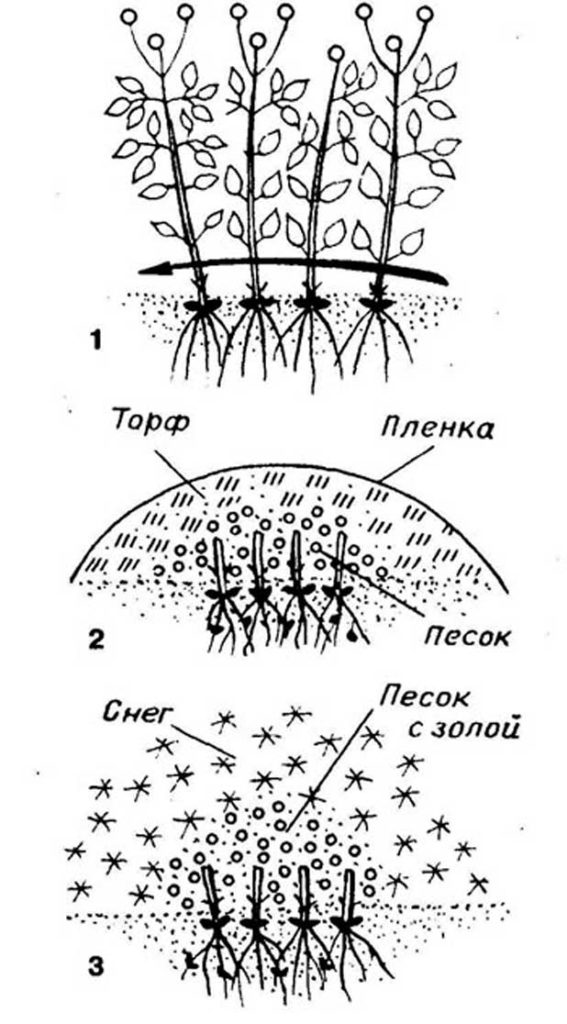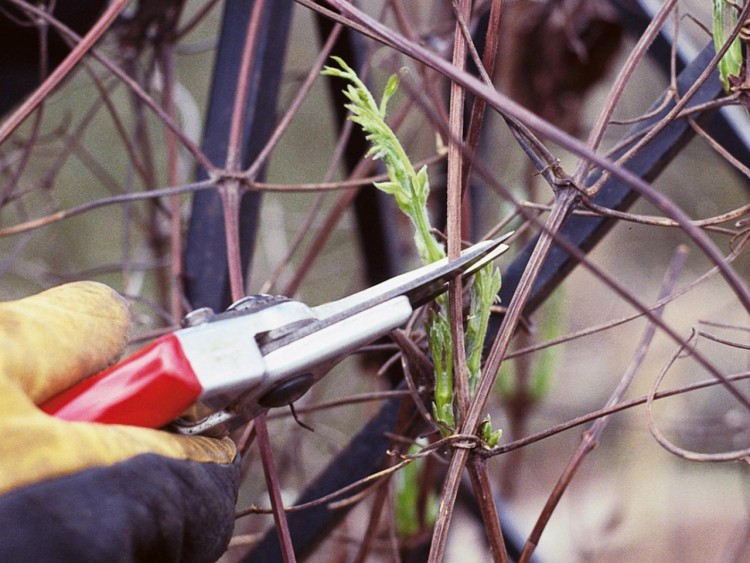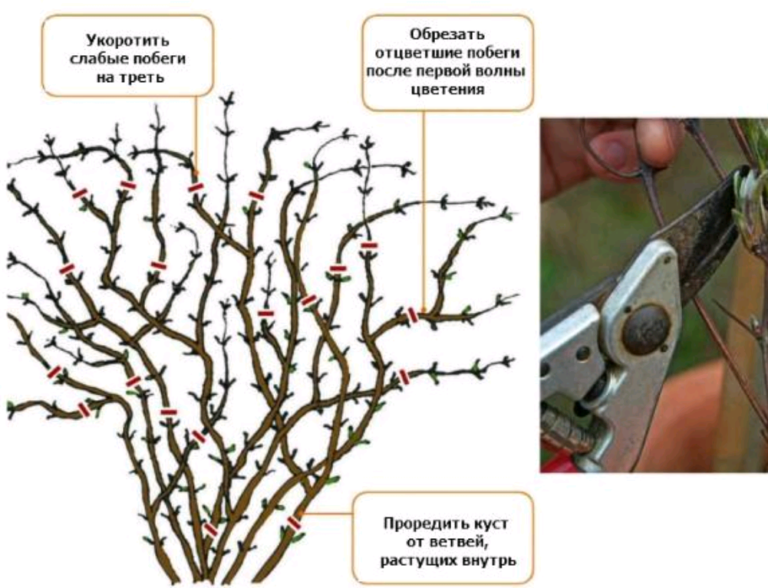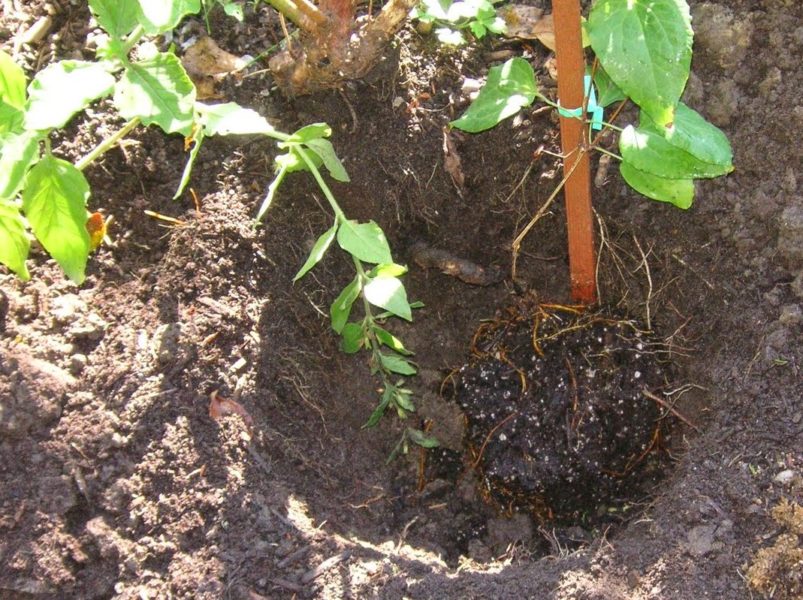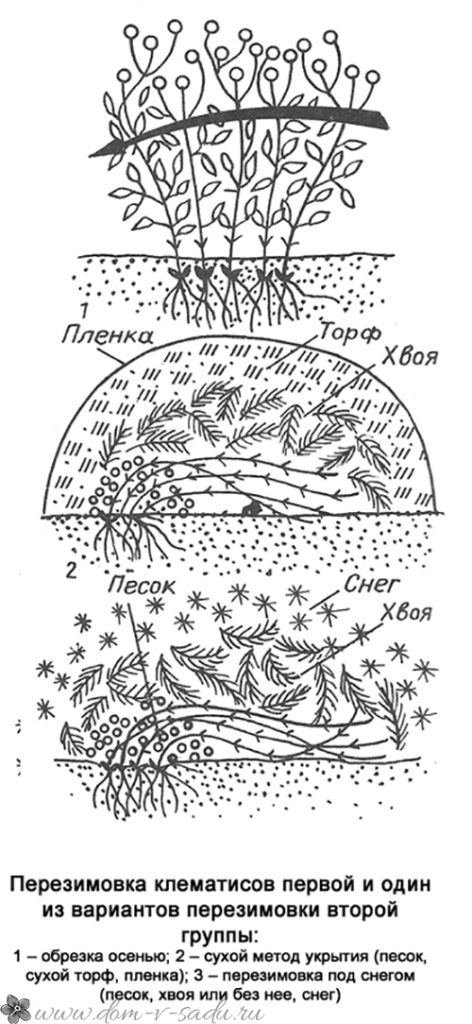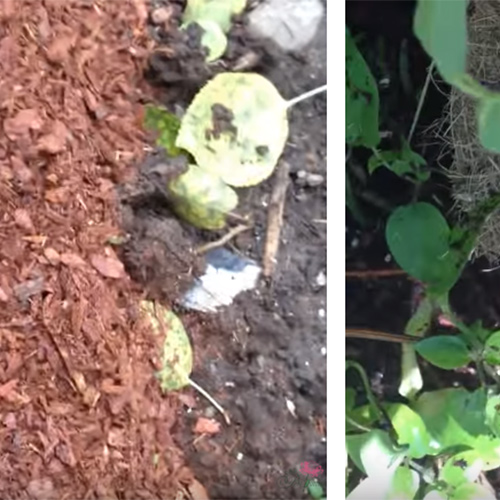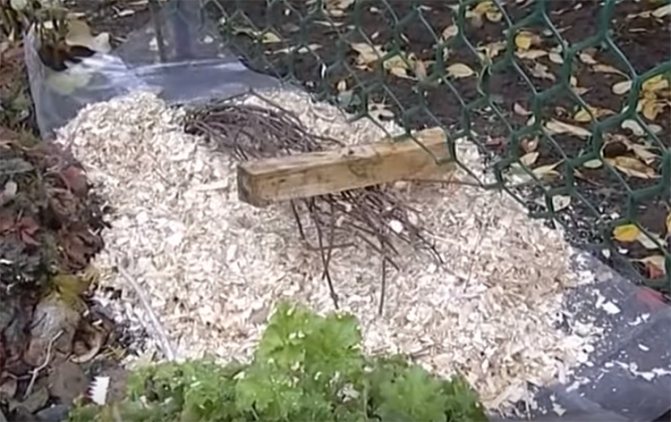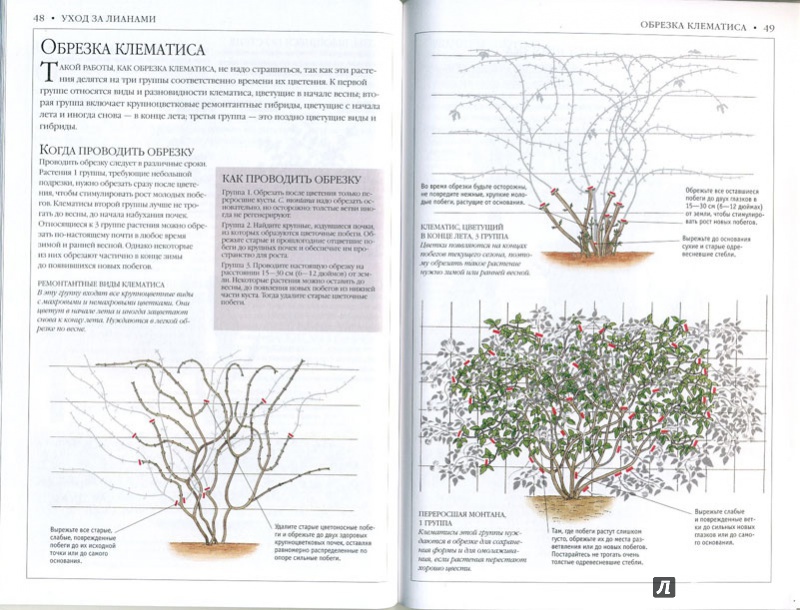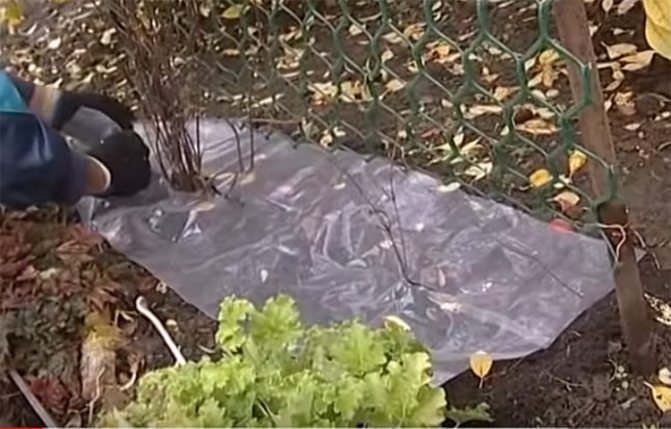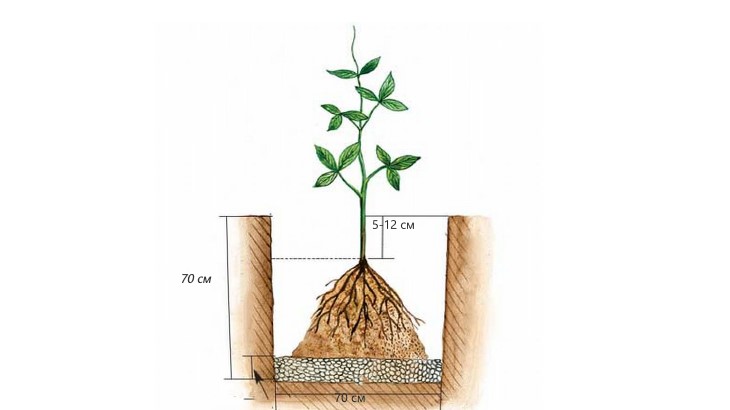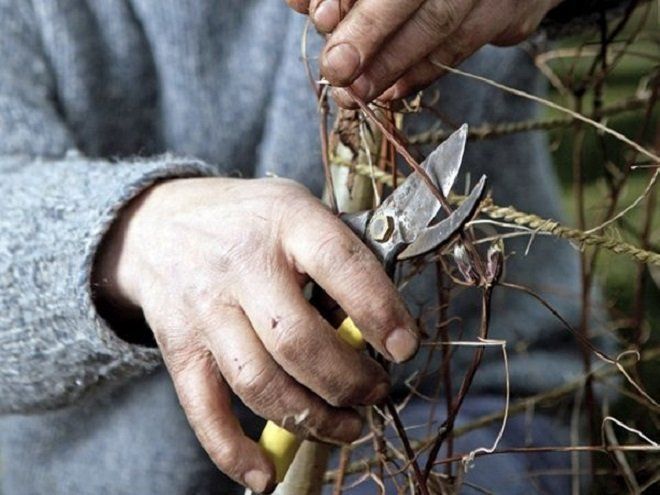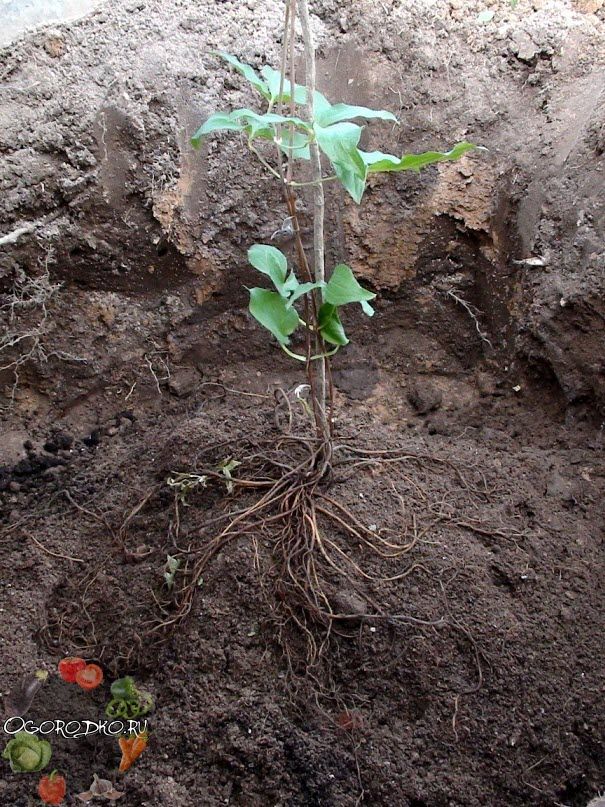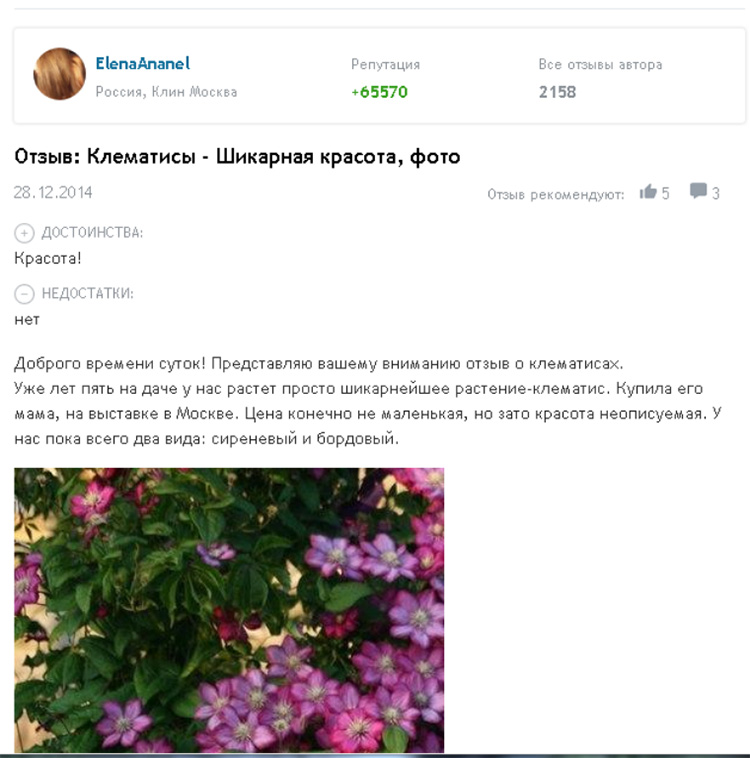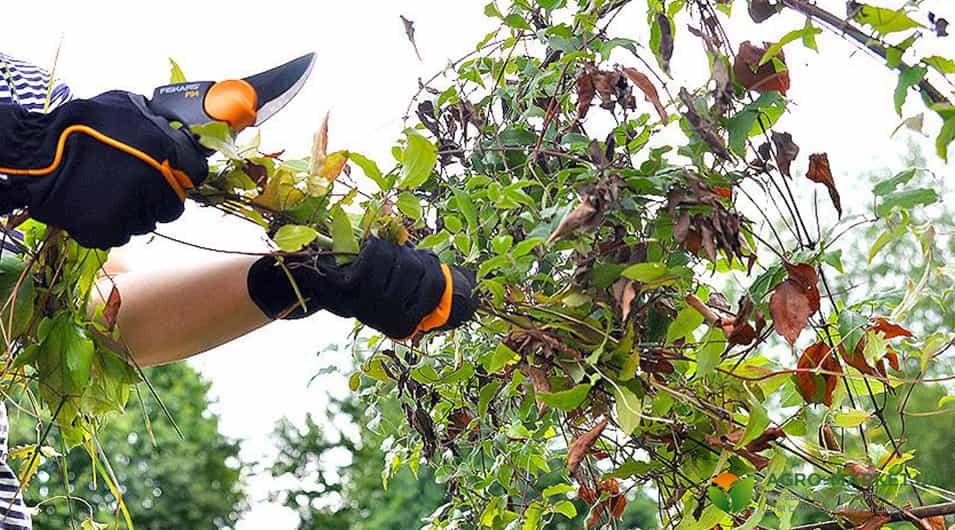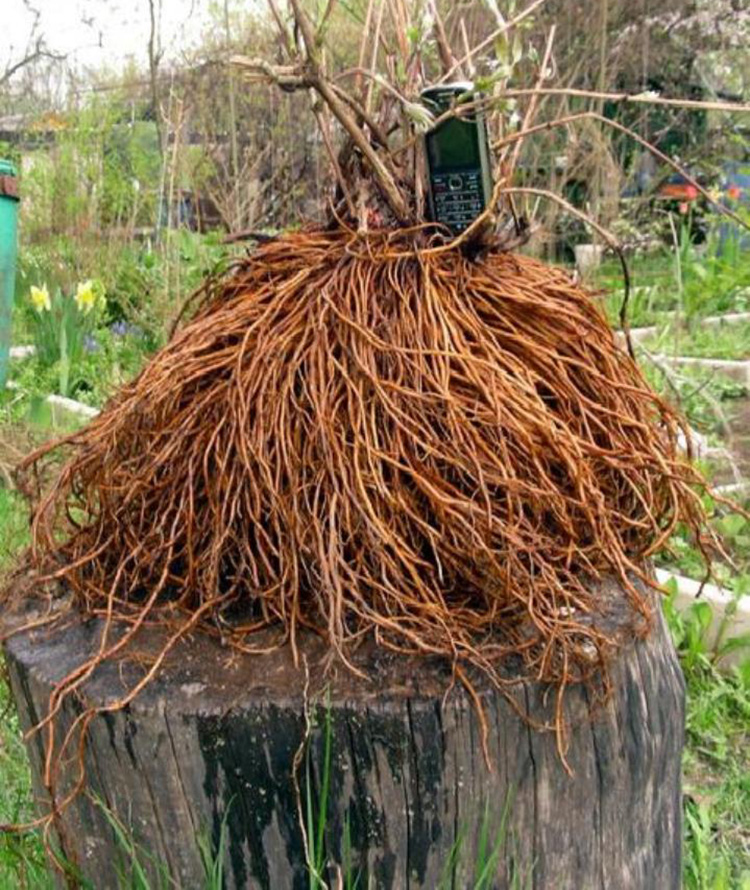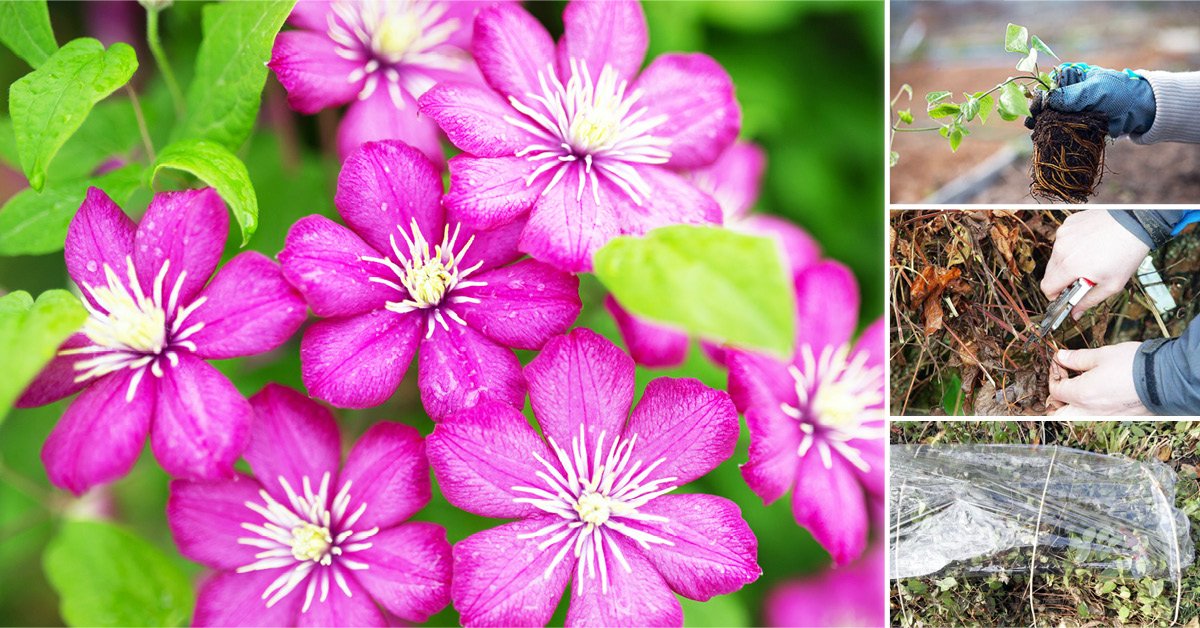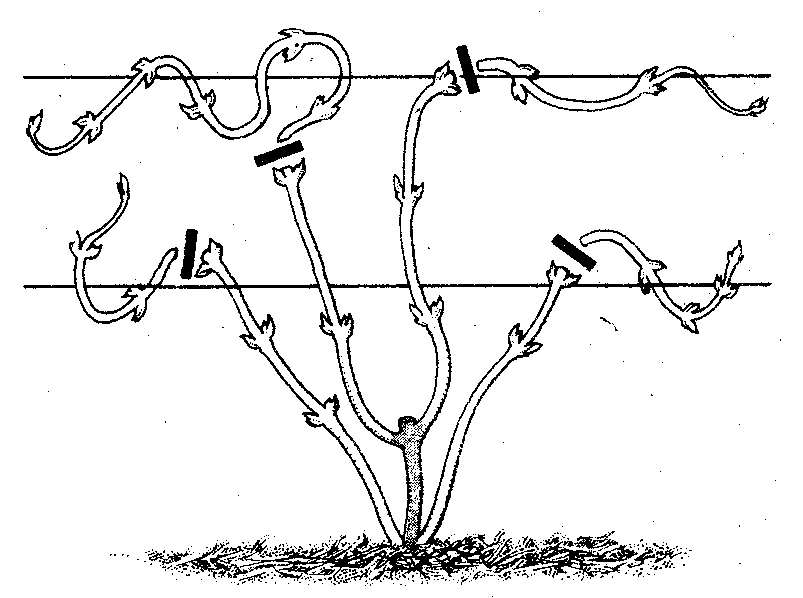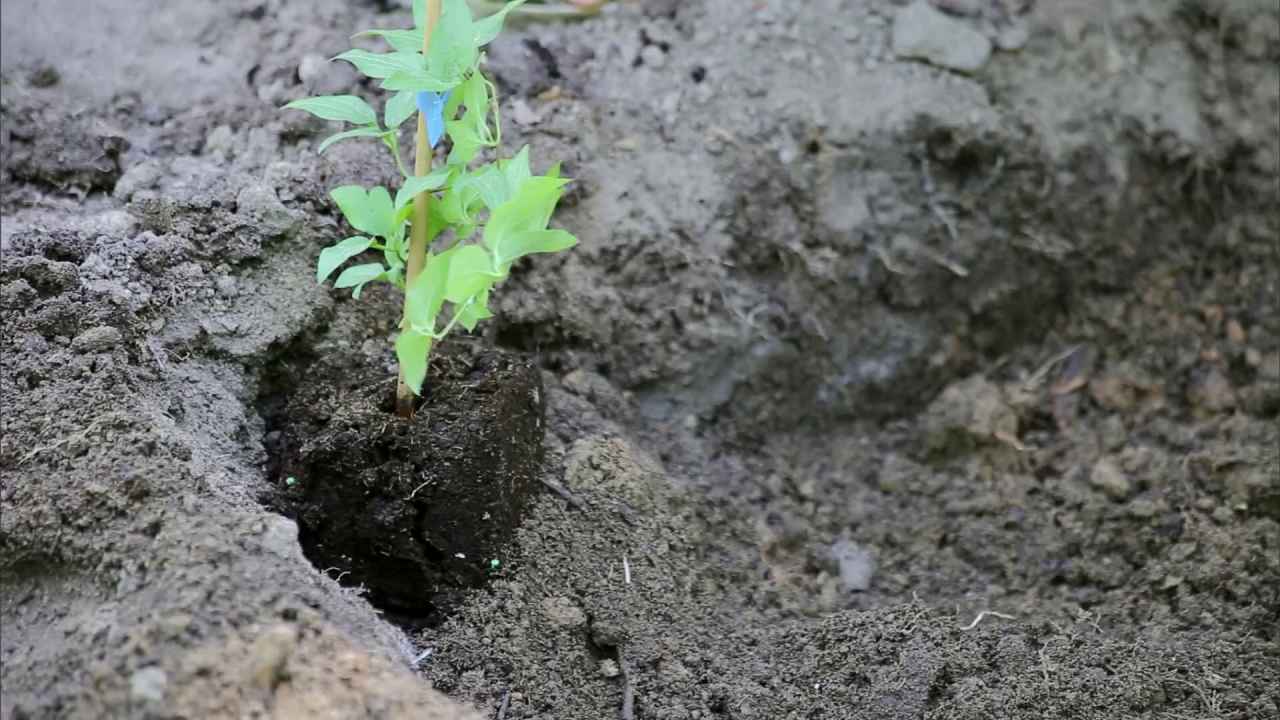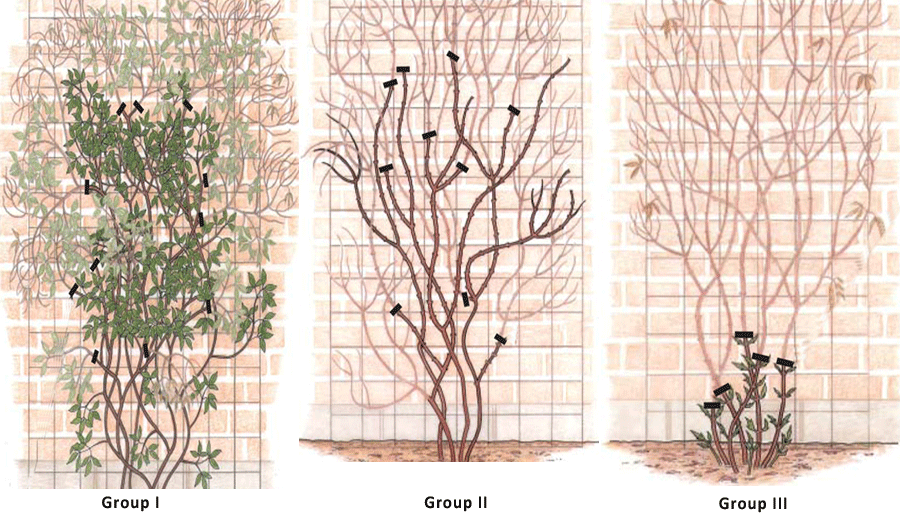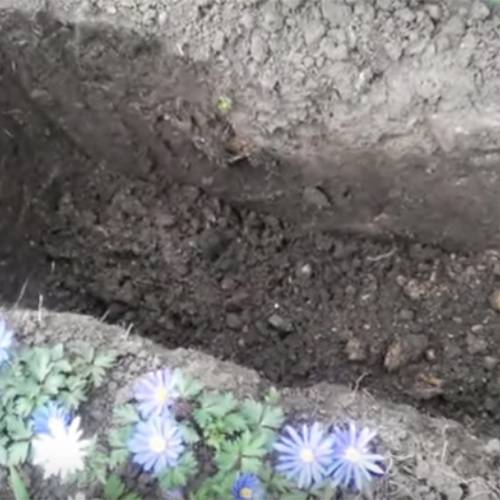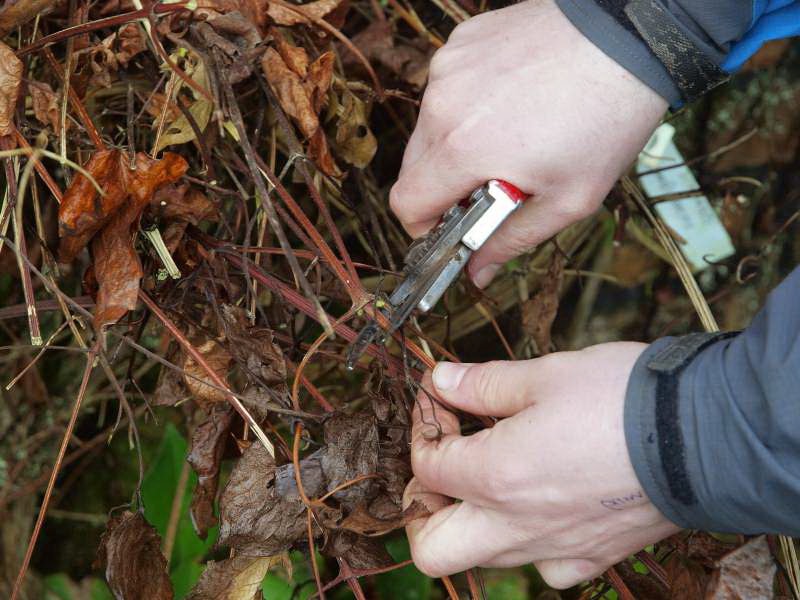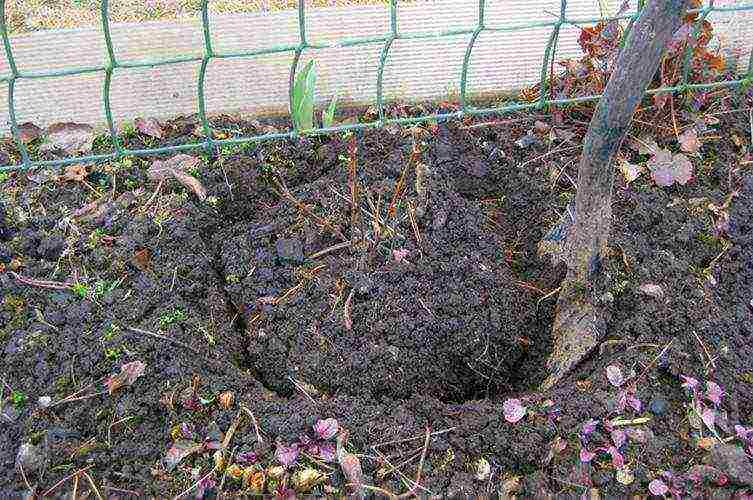Where to plant clematis.
Wet swampy soils are completely unsuitable for a plant, so we exclude for planting areas where there is stagnant water or water from roof drains gets in. Such places guarantee fungal diseases and the death of vines. Also, do not plant a vine near large trees - the roots of the plant are large and will begin to compete with the huge roots of the tree.
I want to remind you that the flowers of the creeper love a sunny place, and the roots love the shade. Therefore, it is good to plant low-growing flowers or ornamental grasses next to it. For example, hosts are great companions for creepers. Another option is root mulching. Needles, sawdust or straw are perfect as mulch.
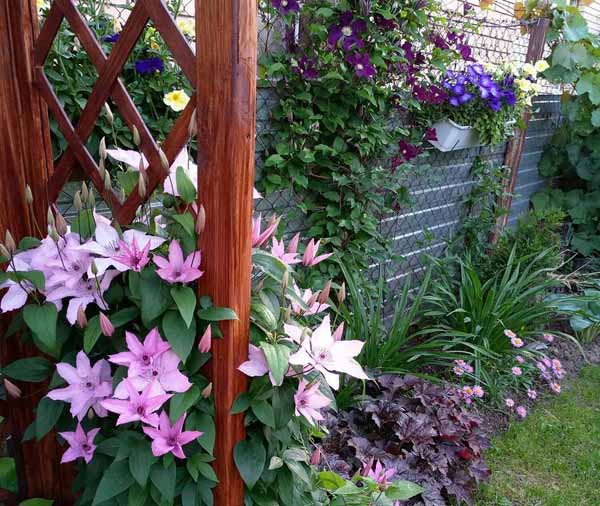
Planting clematis in the Moscow region in open ground
The best time for planting clematis in the Moscow region is spring and the first half of summer, autumn planting is not desirable, the plant will not have time to take root before frost.
They start planting as soon as the ground warms up on the bayonet of the shovel, provided that the seat has been prepared in the fall. Frosts down to -5 ° C at night during early spring planting are not terrible for clematis if they are covered with a double layer of non-woven material.
How and where to plant clematis
- For planting, choose a sunny or semi-shady place (shade is allowed no more than 2-3 hours a day).
- Prepare the landing pit thoroughly. With proper planting and sufficient nutrition in one place, clematis can grow up to twenty years without a transplant.
- Prepare a landing pit about a meter deep and 70 cm to one meter wide. If the groundwater is close, they put a drainage on the bottom with a layer of about 20 cm, then fill the hole with nutrient soil.
- In the presence of fresh or rotted horse manure, it is placed on top of the drainage with a layer of about 40 cm. When the roots of the plant reach it, it will turn into humus.
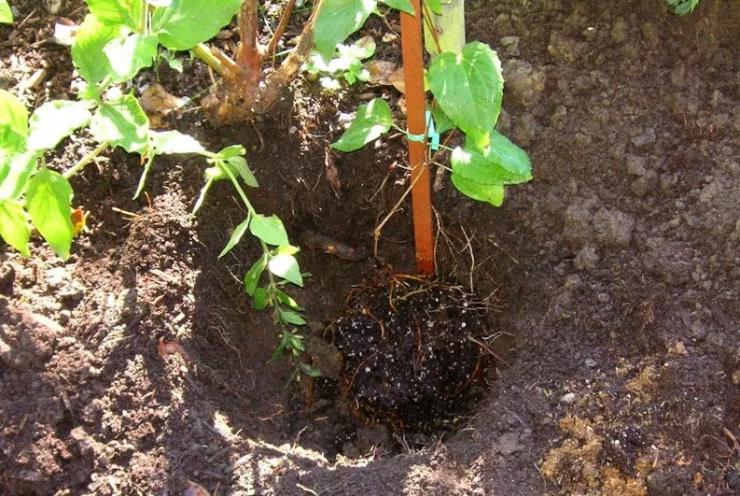
Photo: Landing in open ground
What soil does clematis need?
I prepare the soil for planting clematis like this. The basis is rotted compost, to which I add a little top layer of soil taken out of the pit, then ash, bone or fish meal, complex mineral fertilizer marked "spring" (if planting occurs in spring or the first summer month) and double superphosphate.
How to plant a clematis seedling
It is important to properly prepare the seedling for planting. The day before planting, the seedling is soaked in any of the stimulants: epin, zircon, HB-101 or in sodium humate according to the instructions
The solution is prepared in a plastic container and the entire pot is immersed in it.
A seedling with an open root system is soaked in the same way, but only for a few hours.
Planted in the evening or in cloudy weather, the roots are carefully straightened.
There is one secret when planting clematis, which helps to get a powerful plant with numerous shoots the next year.
Shoots of clematis are laid in a spiral around the base of the plant or directed in the right direction and instilled in about 1-2 cm so that leaves remain on the surface, and the stem itself is underground.
This planting stimulates the formation of additional roots and shoots from each internode. I press the shoots with additional stones.

Photo: Preparing a seedling
Methods for warming plants for the winter

Hilling
We have already written about how a mound of earth is formed at the trunk of a plant. From above, the mound is covered with natural materials. The best shelter for clematis for the winter is snow. Care must be taken that the wind does not carry it around the site. You can put a temporary fence for this. What is the best way to cover clematis for the winter? Tops, leaves, weeds, sawdust can insulate the soil, but there are drawbacks.
These materials absorb moisture, then it is absorbed into the soil. And also pests like to multiply in such plant debris. They lay eggs, which will have a detrimental effect on clematis. It is more advisable to use needles for the lower part of the plant. You can use plastic bags filled with shavings or sawdust.
Combined Shelter
The branches that remained after pruning also need insulation. Hilling is done for the lower part of the plant. Shoots must be bent to the ground, fixed. You can use staples or lay a board with hammered nails next to it, tie twigs to these nails.
The shoots are covered from above with old branches or spruce branches. Snow will fall on them, it will be a reliable shelter for the winter. You can make a "blanket" from plastic bags and dry plant material, laying it on the shoots.
Air shelter
The air method of insulation is suitable for all regions of the Russian Federation. Clematis take cover completely for winter in order to isolate from the environment.
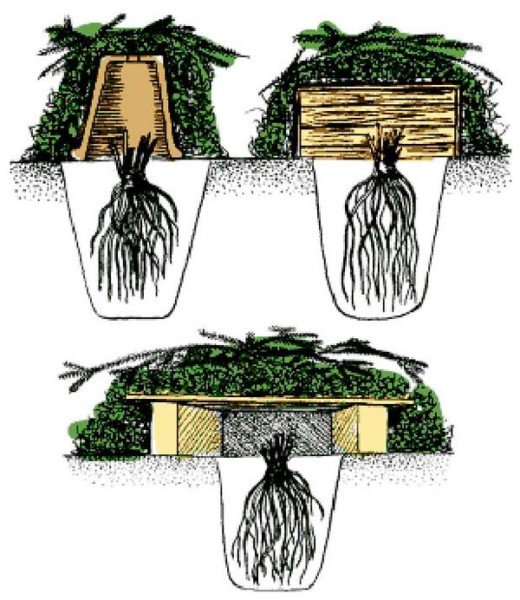
Shelter of individual bushes
To insulate one plant, it is necessary to place a plastic box, a cardboard box above it. From above, the erected clematis shelter is covered with plastic wrap. Instead of this frame, you can use arcs that are installed crosswise. A film is placed on the arcs. The edges of the canvas must be fixed using bricks or pipe cuttings. This method has a drawback. If you do not check the site during the winter, when a thaw sets in, under such a hood, clematis can become resistant. We need to figure out how to create minimal ventilation. You can fold the film on one side to allow air to flow. And for plots near the house, this method is ideal.
Group shelter of clematis
This method is used to cover several bushes at the same time. All branches of clematis are bent down, stacked in a horizontal position. A series of arcs are installed on top. Covering material is laid on the arcs. So that he does not damage the shoots left for the winter, he keeps well, they are tied to the supports of the trellises, on the sides, along the arcs, closer to the top. Another one is located in the center to prevent deformation of the cap under the weight of snow. Having built this complex structure, it is easier to organize the ventilation of clematis. You can open the end pieces so that the air blows out dampness from under the shelter.
How to cover clematis for the winter? For the first layer, you can use roofing paper or any other soft insulation. The second layer can be a thick plastic film. This will be enough even for a harsh winter. When covering, it must be borne in mind that the top cover can blow off. Therefore, it is better to install another row of arcs, which will fix the laid cover.
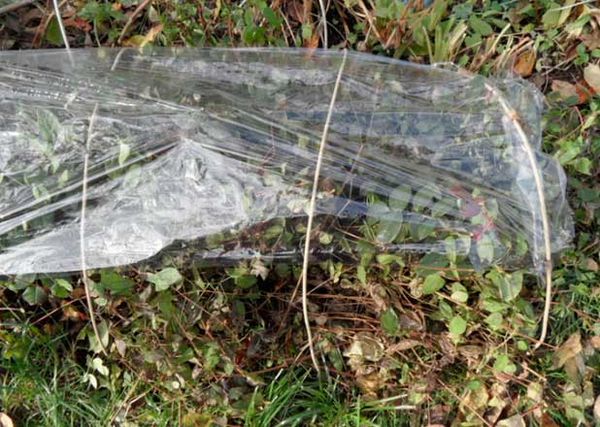
Reinforced insulation
How to save clematis in the northern regions? Reinforced insulation is used only for the regions of the Far North, or where there is very little snow, wind, or low temperatures. Warming is carried out according to the previous method, but the arcs of the second row are installed above the base of the structure with a slight elevation. It turns out an air gap, like an excellent heat insulator. This gap can be filled with insulation material if the weather is too cold. Just do not use covering materials that absorb a large amount of moisture, because it cannot be ruled out that the outer film will be accidentally damaged over the long winter.
Step-by-step instructions for planting clematis in open ground in spring
Knowledge of all the preparatory stages and the scheme of the event itself will help to properly plant a clematis seedling on a site in open ground in spring.
Choosing a place and soil for planting
Before starting the event, you should choose the most suitable place for spring planting of clematis in the open field. This step must be taken responsibly, because the flower does not like transplants and can grow in one place in the garden for many years.
It is recommended to choose a place and soil taking into account the following recommendations:
- The place should be illuminated by the sun, but the plant should be protected from direct scorching rays. Light partial shade is encouraged. This is especially true for varieties with bright colors (they fade with bright rays).
- A flower garden in a country house or a section of a private house should be protected from winds and drafts.
- Avoid lowlands, areas where moisture stagnates, places with a high level of groundwater (they should be at a depth of at least 1-1.2 meters). Growing clematis in such a place is especially critical, since root decay is possible.
- It is necessary to choose a place for planting taking into account the installation of the future support, which is necessary for a climbing plant. That is, a small piece of land should remain next to the planting pit.
- It is recommended to avoid planting near a metal fence that can get hot on hot days. Such a neighborhood can negatively affect the flower.
- Also, if you choose a place in the country near buildings, then choose a place so that the water from the roof does not drain onto the plant.
- The soil for growing clematis should be neutral (pH 6.5), loose, light, nutritious. The plant does not tolerate acidic soils. Optimally planted on loamy soils.
- It is better to plant on a small hill or high bed. This will protect the root system from decay.
Preparing the soil and planting pit
Prepare the soil and the hole in advance so that the soil has time to settle. Preferably in 1-1.5 months or at least a couple of weeks. Site and soil preparation rules:
- The first step is to clean the area, remove stones, debris, weed rhizomes.
- If your site has acidic or slightly acidic soil (which this plant does not accept), then you need to neutralize it. To do this, dig up the soil at the site with the addition of wood ash or dolomite flour (a glass of substance (200 grams) per square meter), or use a special deoxidizer (according to the instructions). And then loosen with a rake so that the substance is evenly distributed and deoxidized the earth.
- If your garden has heavy, clayey soil, it is recommended to dig it up with the addition of lowland peat and sand (one bucket of each ingredient per square meter).
- If the soil on the site is too light (for example, sandy), then it is recommended to make it heavier, that is, put turf soil on the bottom of the pit.
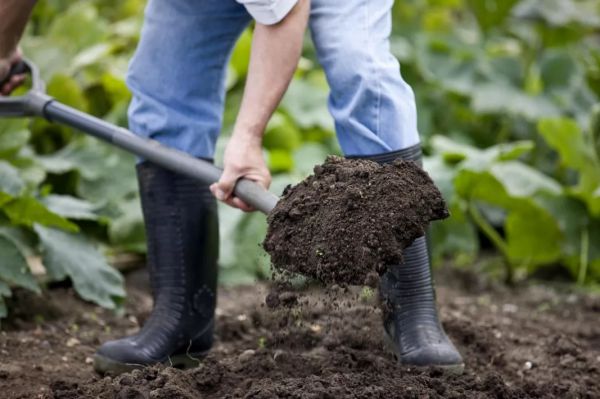
Stages of preparing a planting pit for planting clematis:
- Dig a hole, depth and width - 60 centimeters (or even 70).
- Lay a drainage layer about 15 centimeters thick at the bottom of the planting pit (this is especially true if you are planting on heavy soils or in an area with a high groundwater table). Expanded clay, gravel, pebbles, broken brick can be used as drainage.
- Fill the hole 2/3 full with a mixture of the following ingredients: river sand + lowland peat + humus or compost + turf or fertile topsoil (all ingredients in equal proportions).
- Stir the ingredients well in the pit.
- You can also add 150 grams of complex mineral fertilizer to the pit, for example, "Nitroammofosk" and a glass of wood ash.
- After that, water so that the soil with fertilizers has time to settle before the procedure.
Seedling preparation
It is recommended to prepare a purchased clematis seedling with an open root system before planting in open ground (you do not need to prepare planting material with a closed root system).
As preparation:
- The day before the event, the roots should be soaked in a solution of a growth stimulant drug, for example, Kornevin.
- If you see traces of mold or rotting on the roots, then you need to cut these places to healthy tissue, and then soak them in a fungicide solution, for example, Fitosporin-M.
- Roots that are too long can be cut by a third.
- If there are leaves above the root collar, then they need to be cut off, because the collar needs to be buried.
Description
Previously, clematis was considered a greenhouse plant - in Russian fiction, it was referred to exclusively as clematis. Everyone, having first seen these huge colored stars in a park, at a flower exhibition or a nearby summer cottage, was fascinated by them.
It does not matter monochrome it is a bouquet or an interweaving of vines of various varieties with contrasting flowers - this is a fascinating sight. Clematis will rightfully be able to perform a solo part in your garden
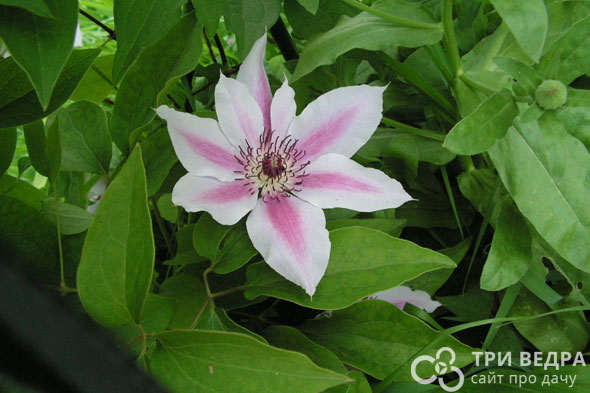
Most clematis are perennial vines, moreover, leaf-climbing: they attach to the supports with leaf stalks, but shrubs and dwarf shrubs are also found. There are about 300 species in total.
Clematis are divided into small-flowered and large-flowered. Small-flowered species are less popular, but differ in unpretentiousness and better winter hardiness. Among them, such types are known as:
- Tunguska,
- Alpine,
- Chinese,
- Virginia.
There are a lot of large-flowered types of clematis:
- Zhakmana (abundant flowering from June to September, color: mainly purple-lilac, white, pink, cherry);
- Viticella (purple, 3v);
- Langunose (last year's shoots bloom in early summer and buds re-bloom in August - September already on young shoots);
- Texas (Taxensis) (blossoms and blooms in the period June - September).
There are 3 trim groups:
- Liana is not cut off, because blooms on the shoots of last year. There are practically no flowers on new shoots. With the freezing of the aboveground part of the flowering in the current summer, it is no longer necessary to wait. The cultivation of clematis of this group is within the power of experienced florists, because requires careful shelter for the winter. The unpretentious "princes" belong to the same group of pruning. Their flowers are medium-sized, significantly inferior in appearance to varietal large-flowered clematis, but the plants are more winter-hardy.
- Requires 1/2 or 1/3 trimming. Representatives of this group bloom both on the shoots of the past and on the shoots of the current year. Moreover, on the shoots of the current year, the flowers are usually simple, on the shoots of the previous year, they are double (if this is inherent in this variety).
- Liana is cut off almost completely, leaving only "tails" of 10-20 cm. Flowering occurs on the shoots of the current year, and clematis belonging to this group grow very quickly: 10-15 cm per day. It is worth taking care of reliable and high supports in advance: trellises, arches, obelisks, nets, etc. the weight of this vine, the dilapidated support may not withstand and your charming blooming cloud will be on the ground.
Further care of clematis
After planting, the plant needs further care: a garter to a support, watering, fertilizing, pruning shoots.
In spring and summer, shoots are tied to supports. Otherwise, they are chaotically intertwined.
Care must be taken to ensure that the branches are not damaged or infected. Supports are installed before planting or immediately after planting.
Otherwise, there is a possibility of damage to the root system.

Ready-made buildings for sale. Most gardeners make their own special pyramids, arches, stuff a large metal mesh or wooden mesh structures on the wall of the building. The growing shoots are first tied up and directed along the support.
The supports must be strong, but no more than 1 cm thick in diameter.
It is recommended to regularly loosen the soil around the bushes, remove weeds, last year's cut shoots and leaves.
Watering
The plant needs weekly watering in spring and autumn, in summer - 2-3 times a week. A young bush needs at least 20 liters of water, a mature one - up to 40 liters. Drip irrigation is effective.
Mulching the soil allows you to keep moisture longer, excludes the appearance of weeds.
Top dressing
Clematis need regular feeding. Before carrying out these works, the site is watered.
During the season, at least 5 dressings are required:
- Late April-early May carry out the first feeding with ammonium nitrate (20 g per 10 l of water). 5-10 liters of fertilizer are poured under each bush. Depends on the size and age of the bush.
- After 7-10 days, an infusion of mullein (1:10), fermented grass (1:10) or chicken droppings (1:15) is used for fertilization. In the absence of organic fertilizers, a urea solution is used (10 g per 10 l of water).
- Two weeks after the second feeding, they are watered with complex fertilizer. You can take 1 tablespoon of “Kemira universal”, dissolve in 10 liters of water. It is advisable to alternate the application of mineral fertilizers with organic ones.
- The fourth feeding is carried out with the onset of budding - with phosphorus-potassium fertilizers.
- The last top dressing with a full complex fertilizer is after the end of flowering and pruning.
Attention! Shrubs do not fertilize during flowering. The flowering time is reduced .. Between the second and third dressings (in May) it is useful to pour milk of lime
Dissolve 100-150 g of lime in 10 liters of water. Use on 1 square meter
Between the second and third dressings (in May), it is useful to pour the milk of lime. Dissolve 100-150 g of lime in 10 liters of water. Use on 1 square meter.
In summer, for monthly dressings, a weak solution of boric acid (1-2 g) and potassium permanganate (2-3 g) are used per 10 liters of water. Shrubs are sprayed with urea (½ tablespoon is dissolved in 10 liters of water).
Clematis - care and cultivation
The beauty of this plant can be compared with exotic flowers due to the large size of the buds and a variety of colors. For the successful cultivation of clematis in the open field, you need to take into account a number of requirements of this garden culture:
- They are light-requiring and grow better in areas flooded with light, but protected from open wind.
- Planting and caring for clematis flowers should take into account that excess water provokes the appearance of putrefactive diseases of the stem.
- In the heat, foliage and flowers are protected from wilting by spraying them from a spray bottle.

Clematis care in autumn
A feature of garden work in this season is the need to prepare shoots for wintering. They consist of three stages, none of which can be excluded:
- Pruning vines. All shoots are shortened to a length of 25-30 cm, each of them must have at least three healthy buds. This will promote the growth of side shoots next spring.
- Top dressing in open ground. Without them, preparing clematis for the winter and leaving in the fall is impossible, because otherwise its immunity to infections will decrease.
- Conservation of summer increments. Flowers on last year's shoots should not be touched, but if they have diseased leaves, they should be removed and the cut site should be treated with a disinfectant solution.
Clematis - wintering in the open field
The more elite the variety of this culture, the lower its ability to frost resistance.
Therefore, the correct wintering of clematis is essential for maintaining the vitality of the flower. It is recommended to minimize harm from temperature extremes in one of the following ways:
- Filling the trunk circle with a layer of river sand mixed with ash. The thickness of the shelter should not be less than 15 cm.
- If planting and caring for clematis in the open field involves the use of supports, then the vines are removed from them, folded on the ground sprinkled with peat, and covered with spruce branches.
- Shoots can be covered with a 20-25 cm layer of a mixture of rotted manure and sawdust, and then covered with foil.
Clematis care in spring
With the arrival of the first warm days, the vines seem to come to life and an intensive vegetation process begins. Spring care for clematis begins with loosening the soil. This will saturate the open ground with oxygen and allow easier access of fertilizers to the root system during subsequent feeding. By May, the plant begins to gain 6-10 cm per day in length, so it is placed on supports made of rope, wire, linen twine or a metal frame.It is worth tying the lower parts of the vine to prevent the risk of mechanical damage to the plant.
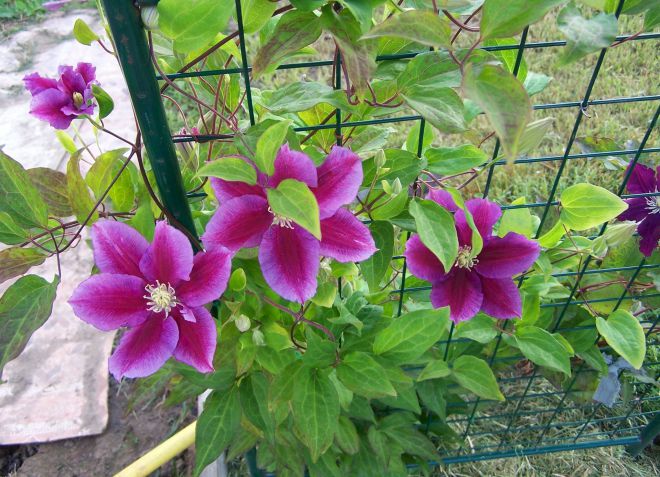
Clematis - feeding care
After planting, the plant needs careful supervision. Vines respond well to care with abundant flowering. For their full development, you will need:
- Watering. This species does not tolerate excess water, but at the same time it must penetrate deep into the soil in order to fully moisturize the roots. It is recommended to water clematis at least once a week, planting and care in the open field, which also involve spraying leaves from a spray bottle in the heat.
- Fertilizer. It is introduced during the period of active growth - exactly until the moment when the first flowers appear on the vines. One soil enrichment per month is enough to avoid nutrient deficiencies. In the spring, feeding and caring for clematis should include copper sulfate, a mixture of organic strawberry fertilizers and milk of lime.
- Weed removal. In the open field, they take all the minerals and moisture for themselves, so they must be removed from the flower bed in a timely manner. You can sow its surface with special grass to protect the flowers.
Further care of clematis
After planting, the plant needs further care: a garter to a support, watering, fertilizing, pruning shoots.
In spring and summer, shoots are tied to supports. Otherwise, they are chaotically intertwined.
Care must be taken to ensure that the branches are not damaged or infected. Supports are installed before planting or immediately after planting.
Otherwise, there is a possibility of damage to the root system.

Ready-made buildings for sale. Most gardeners make their own special pyramids, arches, stuff a large metal mesh or wooden mesh structures on the wall of the building. The growing shoots are first tied up and directed along the support.
The supports must be strong, but no more than 1 cm thick in diameter.
It is recommended to regularly loosen the soil around the bushes, remove weeds, last year's cut shoots and leaves.
Watering
The plant needs weekly watering in spring and autumn, in summer - 2-3 times a week. A young bush needs at least 20 liters of water, a mature one - up to 40 liters. Drip irrigation is effective.
Mulching the soil allows you to keep moisture longer, excludes the appearance of weeds.
Top dressing
Clematis need regular feeding. Before carrying out these works, the site is watered.
During the season, at least 5 dressings are required:
- Late April-early May carry out the first feeding with ammonium nitrate (20 g per 10 l of water). 5-10 liters of fertilizer are poured under each bush. Depends on the size and age of the bush.
- After 7-10 days, an infusion of mullein (1:10), fermented grass (1:10) or chicken droppings (1:15) is used for fertilization. In the absence of organic fertilizers, a urea solution is used (10 g per 10 l of water).
- Two weeks after the second feeding, they are watered with complex fertilizer. You can take 1 tablespoon of “Kemira universal”, dissolve in 10 liters of water. It is advisable to alternate the application of mineral fertilizers with organic ones.
- The fourth feeding is carried out with the onset of budding - with phosphorus-potassium fertilizers.
- The last top dressing with a full complex fertilizer is after the end of flowering and pruning.
Attention! Shrubs do not fertilize during flowering. Flowering time is shortened
Between the second and third dressings (in May), it is useful to pour the milk of lime. Dissolve 100-150 g of lime in 10 liters of water. Use on 1 square meter.
In summer, for monthly dressings, a weak solution of boric acid (1-2 g) and potassium permanganate (2-3 g) are used per 10 liters of water. Shrubs are sprayed with urea (½ tablespoon is dissolved in 10 liters of water).
Planting clematis in the fall in open ground
Soil for clematis
Clematis can grow in one place for up to 30 years, therefore, when choosing a place for them, be extremely responsible - although clematis is not capricious, there are conditions under which you cannot achieve normal plant development. For example, in a warm area, you should not plant clematis in the bright sun or too close to an iron fence, as well as near the walls of buildings, since water should not be allowed to drip from the roof onto the clematis.
Do not plant clematis in those places where there are drafts, since its flowers are large and heavy, and the shoots are fragile and thin, easily breaking from a gust of wind.
Clematis is undemanding to the composition of the soil, but it is undesirable to grow it in acidic soil - the optimum pH for a plant is 6.5, and the groundwater level should be no higher than 120 cm. Lowland and wetlands are unsuitable for growing clematis.
When to plant clematis in autumn
Clematis is planted both in spring and autumn. If you purchased a seedling in the summer, then it makes sense to plant it in the garden without waiting for spring. When is clematis planting in the ground in the fall? The best time for this is September. If clematis is planted later, it may not have time to take root and will die in winter. And if you plant it too early, then, having rooted, it can grow, which on the eve of winter is also detrimental to the plant. Therefore, if a seedling came to you in November, it is better to leave it in the cellar or basement for the winter, and start planting in the spring.
How to plant clematis in the fall
Planting clematis in autumn is carried out in the same way as in spring - it is planted in the soil with a strong deepening, that is, not only the root collar of the seedling should be underground, but also the first pair of shoot buds. This planting stimulates tillering and develops plant resistance to diseases.
A pit for clematis is prepared with a depth of at least 60-70 cm. To fill the pit, prepare an earthen mixture consisting of humus, peat, turf and sand in equal parts. Add a couple of glasses of wood ash, one glass of lime and 150 g of complex mineral fertilizer to the soil mixture.
Lower the seedling with an earthen lump into the hole, fill it first with sand, and then fill the free space with earthen mixture, trampling it down slightly so that no voids remain in the soil. Be sure to water the clematis after planting. In the spring, the seedling will grow, but its development will be slow, and the shoots are thin. Do not despair, this is quite normal - clematis will become a full-fledged ornamental plant only by 3-4 years.
When is it better to plant clematis
It is important to observe the correct time for planting a flower. The plant belongs to a crop with an early growing season.
If you do not plant it in a timely manner, the biological rhythm will be disrupted. This will lead to the fact that the flower will not have time to take root before the cold weather.
Planting dates depend on the region:
- If the procedure is carried out in the spring, it should be done before the buds swell and break open. For the central part of Russia, this time begins from mid-April and lasts until early May.
- Clematis, which were grown in an apartment, are not recommended to be transplanted into open ground until the frost has passed. A change in temperature will be detrimental to the plant.
- If the planting falls in the fall, it should take place no later than at the end of August. This will help the plant to root before frost.
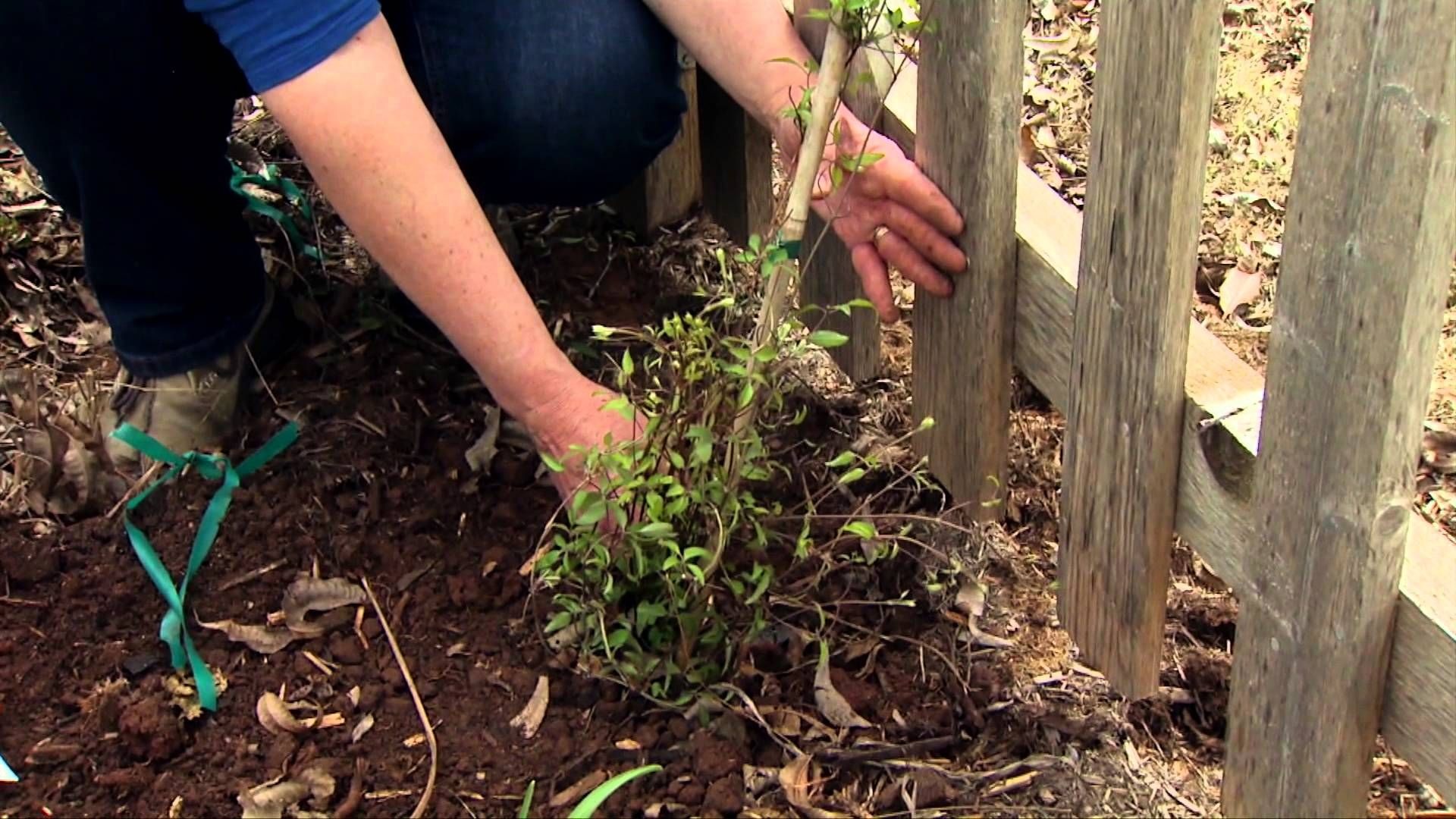
Disembarkation rules
In summer, you can plant clematis with a closed root system. To do this, choose a cloudy day. For the winter, the plant is transferred to a greenhouse or apartment, where it grows until it can be transplanted into open ground.
Important! If a rooted stalk is purchased in a store, packed in a bag with a peat mixture, it should not be planted in open ground. In the first year, it can only be grown in a deep container, removed for the winter in the warmth
Only the next year, the seedlings are moved to open ground to a permanent place.
Features of planting clematis in the autumn season
Gardeners consider autumn to be the best time to plant clematis. The plant manages to strengthen the root system before the beginning of winter. The most optimal soil and air temperature for planting is observed in September.
Despite the fact that many varieties of flower have been bred that tolerate frost perfectly, the autumn plant requires special care. To prepare it for wintering, you will need to carry out a number of activities:
Young seedlings must be covered for the winter. This can be done both with dry leaves and with branches or improvised material, for example, a film, roofing material.
No later than October, the bushes are fed with a mixture of humus and ash.
In the fall, the plant is stopped watered.
It is important to follow this rule, as with night frosts, moisture will destroy the roots.
Bushes that are already one year old are completely freed from dry foliage and pruned. Only the trunk up to 30 centimeters long remains.
After pruning, clematis is spud up, then covered with branches and film.
Important! If the plant has long shoots, it is folded, wrapped with material, laid on the ground and covered with roofing material. This will protect the roots from moisture.
Features of planting clematis in spring
Most clematis varieties are recommended to be planted only in spring. Liana needs time to root properly and prepare for winter. A perennial plant planted in spring will develop a good root system before frost, allowing it to grow for at least twenty years.
Spring planting has its drawbacks
It is important to have time to meet the deadlines, since the bush begins its growing season very early. If you plant a plant with bare roots and blooming buds, it will react sharply to the smallest damage.
Therefore, it is important to have time to plant it before bud break.
Diseases of clematis and their treatment
The most dangerous pathology for clematis is wilting. This is a pathology that manifests itself in the drying out of branches. If the plant gets sick during the growing season, this leads to its death. To prevent the problem, it is necessary to ensure that the roots are properly nourished.
Flower diseases also include:
- Spotting is the formation of fungi carried by snails. Brown spots appear on the leaves, causing necrosis. Leaves begin to fall off. Treatment is carried out with copper sulfate.
- Powdery mildew is a pathology that affects the ground part. Growth and flowering cease, the branches are covered with bloom, the plant gradually dies. Salicylic acid is used for treatment.
Of the pests of clematis, nematodes, spider mites and scale insects are terrible.

Plant diseases
Why does clematis not bloom
The lack of flowering can be observed for various reasons. This can happen if:
- the bush is planted in the wrong place;
- too wet soil;
- a diseased seedling was used;
- there are not enough nutrients in the earth;
- there are a lot of weeds around the bush;
- when circumcision rules are violated.
The lack of flowering can be due to several reasons.
Important! In the first year, the plant does not bloom
Growing clematis from seeds
It is useful for beginners to know that clematis, which can be planted in open ground in spring and autumn, can be grown from seeds, the main thing is to provide them with proper care. The growing process should start with stratification.

The process involves placing the planting material in the freezer for half an hour. After that, the seeds are transferred to a room with room temperature. Here they need to be held for 2 hours, then placed again in the cold. The abrupt temperature change should be carried out three times.
After that, the seeds are soaked for 2 hours in a growth stimulator, washed and spread on a flat surface. The planting material is covered with a plastic bag in a dark room
It is important to periodically open and ventilate them.
At a temperature of +25 ° C, seedlings begin to germinate on the tenth day, they can be planted in a container with soil.Planting should be carried out keeping a small distance between the seedlings.

The land should be mulched with sawdust
If the cold comes, it is important to build a shelter from sawdust or polyethylene. You need to take care of the flower in the same way as for other types of seedlings:
- watering;
- loosen the soil;
- remove weeds;
- add fertilizers.
To strengthen the rhizome, young shoots should be pinched, and weak and damaged branches should be cut off. Healthy shoots need to be tied to the base so that they strengthen and can develop further.

Interesting! How to plant beets correctly in spring
Variety of varieties and types
The genus of clematis has almost 400 species!
Clematis species can be divided into groups based on their flowering period:
- Group 1 - flowering in May-June. This group includes mountain, alpine, large-petaled clematis.
- Group 2 - flowering 2 times a year (beginning and end of summer). This group includes most of the hybrid species.
- Group 3 - bloom in the second half of summer. This group is represented by Texen, Oriental, violet, pollen-leaved clematis.
Important! The frequency of pruning directly depends on the flowering period, which in turn determines the further flowering of clematis.
For example, clematis from the first group must be cut immediately after flowering by 20-50 cm. For representatives of the second group, in the first flowering, flowers appear on last year's shoots, and in the second flowering on the shoots of the current year. You need to prune the plant in the fall. Finally, the plants of the last group, blooming in the second half of summer, need to be cut off almost completely, leaving only 10-30 cm above the ground.
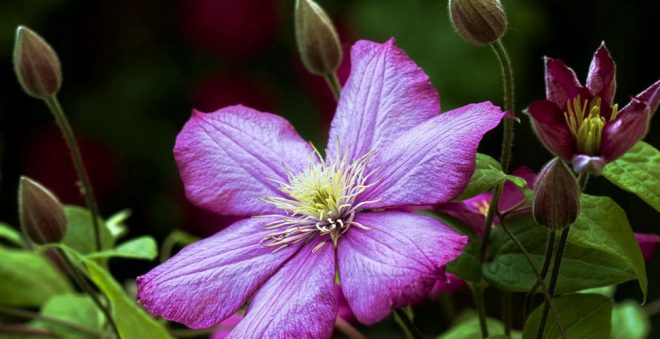
Clematis flower.
The most highly efficient and unusual varieties of clematis include:
-
Texen clematis of Buckland Beauty variety. It grows over 2 m, blooms from July to early autumn with small white-purple flowers resembling bells.
-
Mountain clematis Marjorie. A fast-growing liana with a very lush flowering. Flowering falls in July - at this time the plant is covered with hundreds of light pink lush flowers.
-
Clematis Jacques Tie Dye. Differs in height (up to 4.5 m) and unusual white-purple flowers.
-
Purple Clematis Purpurea Plena Elegans. The main feature is very lush, double flowers of a burgundy or red hue. Blossoms from July to late September.
-
Profusely flowering Viennetta clematis. Reaches 2.5 m you height, densely double flowers - white at the edges with a purple core.
-
Creeping clematis C. repens. Liana is fast growing. During the flowering period, it is covered with small bright lemon flowers.
-
Dancing Queen hybrid clematis. This is a perennial herbaceous vine up to 2 m high. It blooms from June to August - during this period, the plant is covered with numerous double flowers of a pale pink hue.
After flowering, clematis look very decorative and unusual thanks to the pubescent achenes, as in the photo below:

Clematis seeds on plants.
Read on the website: planting and growing escholzia in the open field.

